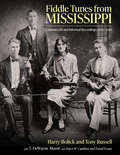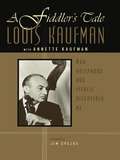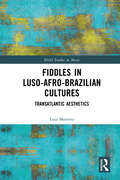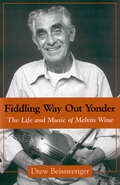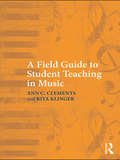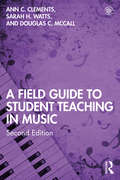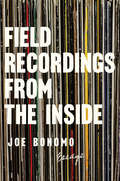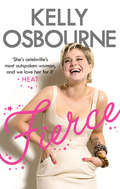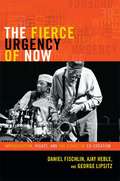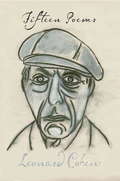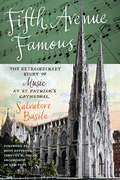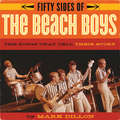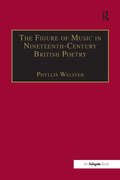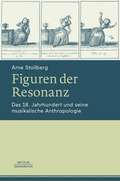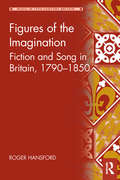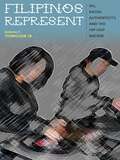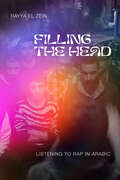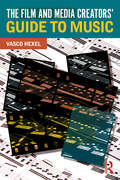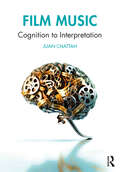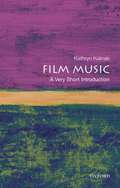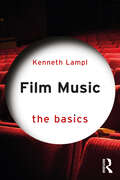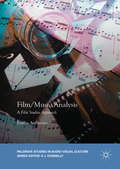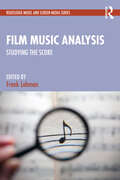- Table View
- List View
Fiddle Tunes from Mississippi: Commercial and Informal Recordings, 1920-2018 (American Made Music Series)
by Harry Bolick Tony RussellIn 2015 University Press of Mississippi published Mississippi Fiddle Tunes and Songs from the 1930s by Harry Bolick and Stephen T. Austin to critical acclaim and commercial success. Roughly half of Mississippi’s rich, old-time fiddle tradition was documented in that volume and Harry Bolick has spent the intervening years working on this book, its sequel. Beginning with Tony Russell’s original mid-1970s fieldwork as a reference, and later working with Russell, Bolick located and transcribed all of the Mississippi 78 rpm string band recordings. Some of the recording artists like the Leake County Revelers, Hoyt Ming and His Pep Steppers, and Narmour & Smith had been well known in the state. Others, like the Collier Trio, were obscure. This collecting work was followed by many field trips to Mississippi searching for and locating the children and grandchildren of the musicians. Previously unheard recordings and stories, unseen photographs and discoveries of nearly unknown local fiddlers, such as Jabe Dillon, John Gatwood, Claude Kennedy, and Homer Grice, followed. The results are now available in this second, companion volume, Fiddle Tunes from Mississippi: Commercial and Informal Recordings, 1920–2018. Two hundred and seventy musical examples supplement the biographies and photographs of the thirty-five artists documented here. Music comes from commercial recordings and small pressings of 78 rpm, 45 rpm, and LP records; collectors’ field recordings; and the musicians’ own home tape and disc recordings. Taken together, these two volumes represent a delightfully comprehensive survey of Mississippi’s fiddle tunes.
A Fiddler's Tale
by Louis KaufmanThis fascinating memoir, written by one of the greatest American violinists of the twentieth century, recounts an extraordinary life in music. Once called by the New York Times "a violinist's violinist and a musician's musician," Louis Kaufman was born in 1905 in Portland, Oregon. He studied violin with Franz Kneisl at New York's Institute of Musical Art. He was the original violist of the Musical Art Quartet (1926-1933) and won the Naumburg Award in 1928, the year of his American solo recital debut in New York's Town Hall. During these early years, he played chamber music with Pablo Casals, Mischa Elman, Jascha Heifetz, Fritz Kreisler, Gregor Piatigorsky, and Efrem Zimbalist, among others. After performing the violin solos for Ernst Lubitsch's 1934 film The Merry Widow, Kaufman became the most sought after violin soloist in Hollywood, playing in some 500 films, including Casablanca, Gone with the Wind, The Diary of Anne Frank, Wuthering Heights, The Grapes of Wrath, and Spartacus. He worked closely with Robert Russell Bennett, Bernard Herrmann, Erich Wolfgang Korngold, Alfred Newman, Miklós Rózsa, Max Steiner, Franz Waxman, and Victor Young. Extraordinary as it seems today, Kaufman was largely responsible for bringing the once-forgotten music of Antonio Vivaldi to its current popularity worldwide among both classical musicians and the general population of music lovers. The book includes a music CD with Kaufman’s performances of Vivaldi’s Concerto 2 of op. 9, Havanaise by Camille Saint Saëns, Nocturne for Violin and Piano by Aaron Copland, Much Ado about Nothing Suite for violin and piano by Erich Wolfgang Korngold, and Smoke Gets in Your Eyes by Jerome Kern, among other favorites.
Fiddles in Luso-Afro-Brazilian Cultures: Transatlantic Aesthetics (ISSN)
by Luiz MorettoFiddles in Luso-Afro-Brazilian Cultures presents fresh data and debates drawn from extensive research to broaden the study of African music by focusing on fiddle playing, exploring rhythm aesthetics and tonal systems within cultural contexts. Focused on Cape Verde, Mozambique and Brazil, the research maps cultural affiliations, addressing cultural displacement and historical ties. It engages with post-colonial power dynamics, highlighting fiddle playing as a form of resistance and revival.Primarily aimed at academic researchers in ethnomusicology and related fields, the book provides detailed analytical descriptions and narratives of artists, instruments and playing styles. It contributes to discussions on music, decolonisation and diasporic communities’ demands for authenticity and recognition. By revealing lesser-known fiddle traditions, it enriches the world music genre, attracting both academic and general readers interested in transcultural music studies.
Fiddling Way Out Yonder: The Life and Music of Melvin Wine (American Made Music Series)
by Drew BeisswengerFrom a small mountain town in West Virginia, elder fiddler Melvin Wine has inspired musicians and music enthusiasts far beyond his homeplace. Music, community, and tradition influence all aspects of life in this rural region. Fiddling Way Out Yonder: The Life and Music of Melvin Wine shows how in Wine's playing and teaching all three have created a vital and enduring legacy. Wine has been honored nationally for his musical skills and his leadership role in an American musical tradition. A farmer, a coal miner, a father of ten children, and a deeply religious man, he has played music from the hard lessons of his own experience and shaped a musical tradition even while passing it to others. Fiddling Way Out Yonder examines the fiddler, his music, and its context from a variety of perspectives. Many rousing fiddlers came from isolated mountain regions like Melvin's home stomp. The book makes a point to address the broad historical issues related both to North American fiddling and to Wine's personal history. Wine has spent almost all of his ninety-two years in rural Braxton County, an area where the fiddle and dance traditions that were strong during his childhood and early adult life continue to be active today. Utilizing models from folklore studies and ethnomusicology, Fiddling Way Out Yonder discusses how community life and educational environment have affected Melvin's music and his approaches to performance. Such a unique fiddler deserves close stylistic scrutiny. The book reveals Wine's particular tunings, his ways of holding the instrument, his licks, his bowing techniques and patterns, his tune categories, and his favorite keys. The book includes transcriptions and analyses of ten of Melvin's tunes, some of which are linked to minstrelsy, ballad singing traditions, and gospel music. Narratives discuss the background of each tune and how it has fit into Melvin's life. While his music is tied to community and family traditions, Melvin is a unique and complex person. This biography heralds a musician who wants both to communicate the spirit of his mountains and to sway an audience into having an old-fashioned good time.
A Field Guide to Student Teaching in Music
by Ann C. Clements Rita KlingerA Field Guide to Student Teaching in Music is a practical guide focused on the link between music education coursework and the field-based aspects of the student teaching experience. It addresses general topics that are common to all music placements, as well as those topics that are of specific interest to the general, choral, and instrumental music classrooms. This text builds on theoretical materials typically covered in music methods courses, yet it is not specific to any one particular teaching pedagogy, making it flexible enough for use in a variety of music teaching settings. It will guide students through the student teaching process as they make the transition from student to music educator.
A Field Guide to Student Teaching in Music
by Ann C. Clements Sarah H. Watts Douglas C. McCallA Field Guide to Student Teaching in Music, Second Edition, serves as a practical guide for the music education student, one that recognizes the importance of effective coursework while addressing the unique field-based aspects of the music classroom. Student teaching in music is a singular experience, presenting challenges beyond those encountered in general education classroom settings: educators must plan for singing and movement, performances and rehearsals, intensive parent involvement, uniforms, community outreach, and much more. This guide explores such topics common to all music placements as well as those specific to general, choral, and instrumental music classrooms, building on theoretical materials often covered in music methods courses and yet not beholden to any one pedagogy, thus allowing for a dynamic and flexible approach for various classroom settings. New to the second edition: Companion website featuring downloadable worksheets, résumé support, a cooperating teacher guide, and more: www.musicstudentteaching.com A new chapter on the transition from student to student teacher Expanded discussions on the interview process, including mock interviews, interviewing techniques, and online interview prep Updated content throughout to reflect current practices in the field. Leading readers through the transition from student to teacher, A Field Guide to Student Teaching in Music, Second Edition, represents a necessary update to the first edition text published a decade ago, an indispensable resource that provides the insights and skillsets students need to launch successful careers as music educators.
Field Recordings from the Inside: Essays
by Joe BonomoUsing as its epigraph and unifying principle Luc Sante’s notion that "Every human being is an archeological site,” Field Recordings from the Inside provides a deep and personal examination at the impact of music on our lives. Bonomo effortlessly moves between the personal and the critical, investigating the ways in which music defines our personalities, tells histories, and offers mysterious, often unbidden access into the human condition. The book explores the vagaries and richness of music and music-making-from rock and roll, punk, and R&B to Frank Sinatra, Nashville country, and Delta blues-as well as the work of a diverse group of artists and figures-Charles Lamb, music writer Lester Bangs, painter and television personality Bob Ross, child country musician Troy Hess, and songwriter Greg Cartwright.Mining the often complex natures and shapes of the creative process, Field Recordings from the Inside is a singular work that blends music appreciation, criticism, and pop culture from one of the most critically acclaimed music writers of our time.
Fierce
by Kelly OsbourneThis no-holds-barred account of Kelly Obsourne's upbringing is as shocking as it is disarmingly funny. From stories about her father's alcoholism to pushing over portaloos on tour, Kelly unflinchingly deals with the extraordinary experiences that have made up her life so far:'Kelly Osbourne has written Fierce, a handbook for teenage girls/memoir of adolescence lived under very bright lights. After reading it, and her anecdotes about her mum's early experiments with home waxing, and her dad snipping off her thong, and Amy Winehouse complimenting her on her tits, and the confidence that comes with Vicodin, as well as the fact boxes with advice about bullying and hair straighteners, I like her very much.' Eva Wiseman, Observer
The Fierce Urgency of Now: Improvisation, Rights, and the Ethics of Cocreation
by Fischlin Daniel Heble Ajay Lipsitz GeorgeThe Fierce Urgency of Now links musical improvisation to struggles for social change, focusing on the connections between the improvisation associated with jazz and the dynamics of human rights struggles and discourses. The authors acknowledge that at first glance improvisation and rights seem to belong to incommensurable areas of human endeavor. Improvisation connotes practices that are spontaneous, personal, local, immediate, expressive, ephemeral, and even accidental, while rights refer to formal standards of acceptable human conduct, rules that are permanent, impersonal, universal, abstract, and inflexible. Yet the authors not only suggest that improvisation and rights can be connected; they insist that they must be connected. Improvisation is the creation and development of new, unexpected, and productive cocreative relations among people. It cultivates the capacity to discern elements of possibility, potential, hope, and promise where none are readily apparent. Improvisers work with the tools they have in the arenas that are open to them. Proceeding without a written score or script, they collaborate to envision and enact something new, to enrich their experience in the world by acting on it and changing it. By analyzing the dynamics of particular artistic improvisations, mostly by contemporary American jazz musicians, the authors reveal improvisation as a viable and urgently needed model for social change. In the process, they rethink politics, music, and the connections between them.
A Fiery Gospel: The Battle Hymn of the Republic and the Road to Righteous War (Religion and American Public Life)
by Richard M. GambleSince its composition in Washington's Willard Hotel in 1861, Julia Ward Howe's "Battle Hymn of the Republic" has been used to make America and its wars sacred. Few Americans reflect on its violent and redemptive imagery, drawn freely from prophetic passages of the Old and New Testaments, and fewer still think about the implications of that apocalyptic language for how Americans interpret who they are and what they owe the world. In A Fiery Gospel, Richard M. Gamble describes how this camp-meeting tune, paired with Howe's evocative lyrics, became one of the most effective instruments of religious nationalism. He takes the reader back to the song's origins during the Civil War, and reveals how those political and military circumstances launched the song's incredible career in American public life. Gamble deftly considers the idea behind the song—humming the tune, reading the music for us—all while reveling in the multiplicity of meanings of and uses to which Howe's lyrics have been put. "The Battle Hymn of the Republic" has been versatile enough to match the needs of Civil Rights activists and conservative nationalists, war hawks and peaceniks, as well as Europeans and Americans. This varied career shows readers much about the shifting shape of American righteousness. Yet it is, argues Gamble, the creator of the song herself—her Abolitionist household, Unitarian theology, and Romantic and nationalist sensibilities—that is the true conductor of this most American of war songs. A Fiery Gospel depicts most vividly the surprising genealogy of "The Battle Hymn of the Republic," and its sure and certain position as a cultural piece in the uncertain amalgam that was and is American civil religion.
Fiesta de diez pesos: Music And Gay Identity In Special Period Cuba (SOAS Studies in Music Series)
by Moshe MoradThe ‘Special Period’ in Cuba was an extended era of economic depression starting in the early 1990s, characterized by the collapse of revolutionary values and social norms, and a way of life conducted by improvised solutions for survival, including hustling and sex-work. During this time there developed a thriving, though constantly harassed and destabilized, clandestine gay scene (known as the ‘ambiente’). In the course of eight visits between 1995 and 2007, the last dozen years of Fidel Castro’s reign, Moshe Morad became absorbed in Havana’s gay scene, where he created a wide social network, attended numerous secret gatherings-from clandestine parties to religious rituals-and observed patterns of behavior and communication. He discovered the role of music in this scene as a marker of identity, a source of queer codifications and identifications, a medium of interaction, an outlet for emotion and a way to escape from a reality of scarcity, oppression and despair. Morad identified and conducted his research in different types of ‘musical space,’ from illegal clandestine parties held in changing locations, to ballet halls, drag-show bars, private living-rooms and kitchens and santería religious ceremonies. In this important study, the first on the subject, he argues that music plays a central role in providing the physical, emotional, and conceptual spaces which constitute this scene and in the formation of a new hybrid ‘gay identity’ in Special-Period Cuba.
Fifteen Poems
by Leonard Cohen<P>This selection of poems by Leonard Cohen, one of the most acclaimed singer-songwriters in the world, is accompanied by twenty-four of his striking and provocative drawings. <P>Cohen first made his name as a poet more than half a century ago and since then his achievements in poetry and music have made him an internationally revered figure. These fifteen poems, including "Death of a Lady's Man," "On Hearing a Name Long Unspoken," and "The Embrace," are drawn from across his remarkable career and appear here for the first time with his illustrations. With its lyrical intensity and sensual immediacy, Fifteen Poems offers a potent distillation of the genre-crossing genius of one of the most admired artists of our time.
Fifth Avenue Famous: The Extraordinary Story of Music at St. Patrick's Cathedral
by Salvatore Basile Timothy Michael Dolan Archbishop of New YorkVictorian-era divas who were better paid than some corporate chairmen, the boy soprano who grew up to give Bing Crosby a run for his money, music directors who were literally killed by the job—the plot of a Broadway show or a dime-store novel? No, the unique and colorful history of St. Patrick’s Cathedral. Since its inception more than 125 years ago, the Cathedral Choir has been considered the gold standard of liturgical music—an example of artistic excellence that has garnered worldwide renown. Yet behind this stately facade lies an intriguing mix of New York history, star secrets, and high-level office politics that has made the choir not only a source of prime musical entertainment but also fodder for tabloids and periodicals across the nation. In this unique and engaging book, readers are treated to a treasure trove of vibrant characters, from opera stars from around the world to the thousands of volunteer singers who brought their own hopes and dreams—and widely varying musical abilities—to the fabled choir. As the city’s preeminent Catholic institution, St. Patrick’s Cathedral has served one of the most dynamic and diverse communities in the world for well over a century. It has been intimately entwined with the history of New York: a major center of culture in the nation’s cultural capital. The Cathedral Choir provides an extraordinary and largely overlooked insight into this history, and in Salvatore Basile’s pitch-perfect exploration it becomes a microcosm for the larger trends, upheavals, and events that have made up the history of the city, the nation, and even the world. Basile also illuminates the choir’s important role in New Yorkers’ responses to some of the most momentous events of the past one hundred years, from world wars to world’s fairs, from the sinking of the Titanic to 9/11, as well as its central role in the rituals and celebrations that have made life in the city more joyful—and bearable—for millions of people over the decades. While the phrase “church choir” usually evokes the image of a dowdy group of amateurs, the phrase “Choir of St. Patrick’s Cathedral” has always meant something quite different. Salvatore Basile’s splendid history shows just how different, and just how spectacular, the music of St. Patrick’s is.
Fifty Sides of the Beach Boys: The Songs That Tell Their Story
by Mark Dillon&“A vivid account . . . Young and old fans alike will enjoy&” (Publishers Weekly). This book offer a unique journey through The Beach Boys&’ long, fascinating history by telling the stories behind fifty of the band&’s greatest songs from the perspective of group members, collaborators, fellow musicians, and notable fans. Filled with new interviews with music legends such as Brian Wilson, Mike Love, Alan Jardine, Bruce Johnston, David Marks, Blondie Chaplin, Randy Bachman, Roger McGuinn, John Sebastian, Lyle Lovett, Alice Cooper, and Al Kooper, and commentary from a younger generation such as Matthew Sweet, Carnie Wilson, Daniel Lanois, Cameron Crowe, and Zooey Deschanel, this story of pop culture history both explores the darkness and difficulties with which the band struggled, and reminds us how their songs could make life feel like an endless summer.
The Figure of Music in Nineteenth-Century British Poetry (Music In Nineteenth-century Britain Ser.)
by Phyllis WeliverHow was music depicted in and mediated through Romantic and Victorian poetry? This is the central question that this specially commissioned volume of essays sets out to explore in order to understand better music's place and its significance in nineteenth-century British culture. Analysing how music took part in and commented on a wide range of scientific, literary, and cultural discourses, the book expands our knowledge of how music was central to the nineteenth-century imagination. Like its companion volume, The Idea of Music in Victorian Fiction (Ashgate, 2004) edited by Sophie Fuller and Nicky Losseff, this book provides a meeting place for literary studies and musicology, with contributions by scholars situated in each field. Areas investigated in these essays include the Romantic interest in national musical traditions; the figure of the Eolian harp in the poetry of Coleridge and Shelley; the recurring theme of music in Blake's verse; settings of Tennyson by Parry and Elgar that demonstrate how literary representations of musical ideas are refigured in music; George Eliot's use of music in her poetry to explore literary and philosophical themes; music in the verse of Christina and Dante Gabriel Rossetti; the personification of lyric (Sappho) in a song cycle by Granville and Helen Bantock; and music and sexual identity in the poetry of Wilde, Symons, Michael Field, Beardsley, Gray and Davidson.
Figuren der Resonanz: Das 18. Jahrhundert und seine musikalische Anthropologie
by Arne StollbergAb der Mitte des 17. Jahrhunderts vollzog sich in der Medizin ein Paradigmenwechsel von hoher ästhetischer Relevanz. Hatten die Nerven bis dahin als Transportkanäle für die „Lebensgeister“ gegolten, so trat nunmehr eine konkurrierende Theorie auf den Plan, nach der es sich um elastische Fasern handle, die in Analogie zur Saitenvibration, also über das Prinzip der Schwingung zu erklären seien. Der menschliche Leib avancierte buchstäblich zu einem Musikinstrument, das emotionale Erleben (nicht nur) von Musik zu einem Resonanzeffekt. Die Folgen dieser Sichtweise waren einschneidend: Das vorliegende Buch zeigt anhand zahlreicher Quellen aus den Bereichen Musik, Medizin, Literatur und Ästhetik, wie eine „musikalische Anthropologie“ entstand, die wiederum auf die Kompositionspraxis zurückwirkte, etwa bei Carl Philipp Emanuel Bach, Georg Anton Benda und Wolfgang Amadeus Mozart.
Figures of the Imagination: Fiction and Song in Britain, 1790–1850 (Music in Nineteenth-Century Britain)
by Roger HansfordThis new study of the intersection of romance novels with vocal music records a society on the cusp of modernisation, with a printing industry emerging to serve people’s growing appetites for entertainment amidst their changing views of religion and the occult. No mere diversion, fiction was integral to musical culture and together both art forms reveal key intellectual currents that circulated in the early nineteenth-century British home and were shared by many consumers. Roger Hansford explores relationships between music produced in the early 1800s for domestic consumption and the fictional genre of romance, offering a new view of romanticism in British print culture. He surveys romance novels by Ann Radcliffe, Matthew Lewis, Sir Walter Scott, James Hogg, Edward Bulwer and Charles Kingsley in the period 1790–1850, interrogating the ways that music served to create mood and atmosphere, enlivened social scenes and contributed to plot developments. He explores the connections between musical scenes in romance fiction and the domestic song literature, treating both types of source and their intersection as examples of material culture. Hansford’s intersectional reading revolves around a series of imaginative figures – including the minstrel, fairies, mermaids, ghosts, and witches, and Christians engaged both in virtue and vice – the identities of which remained consistent as influence passed between the art forms. While romance authors quoted song lyrics and included musical descriptions and characters, their novels recorded and modelled the performance of songs by the middle and upper classes, influencing the work of composers and the actions of performers who read romance fiction.
Filipinos Represent: DJs, Racial Authenticity, and the Hip-hop Nation
by Antonio T. Tiongson Jr.The &“Hip-hop Nation&” has been scouted, staked out, and settled by journalists and scholars alike. Antonio T. Tiongson Jr. steps into this well-mapped territory with questions aimed at interrogating how nation is conceptualized within the context of hip-hop. What happens, Tiongson asks, to notions of authenticity based on hip-hop&’s apparent blackness when Filipino youth make hip-hop their own? Tiongson draws on interviews with Bay Area–based Filipino American DJs to explore the authenticating strategies they rely on to carve out a niche within DJ culture. He shows how Filipino American youth involvement in DJing reconfigures the normal boundaries of Filipinoness predicated on nostalgia and cultural links with an idealized homeland. Filipinos Represent makes the case that while the engagement of Filipino youth with DJ culture speaks to the broadening racial scope of hip-hop—and of what it means to be Filipino—such involvement is also problematic in that it upholds deracialized accounts of hip-hop and renders difference benign. Looking at the ways in which Filipino DJs legitimize their place in an expressive form historically associated with African Americans, Tiongson examines what these complex forms of identification reveal about the contours and trajectory of contemporary U.S. racial formations and discourses in the post–civil rights era.
Filling the Head: Listening to Rap in Arabic (Public Cultures of the Middle East and North Africa)
by Rayya El ZeinWhen asked what drew them to experimental Arabic-language rap, performers and fans shared a common refrain: various artists or tracks "filled their head" ('abba rasshom), offering relief from their dissatisfaction, cynicism, resignation, and disgust with contemporary politics and society. Based on ethnographic research in Ramallah (Palestine), Amman (Jordan), and Beirut (Lebanon), Filling the Head reveals how youths in these cities have maneuvered the challenges of making music while also navigating shifting geopolitical landscapes. Through these everyday experiences of being moved by music or ideas, Rayya El Zein explores how ordinary patterns of motion and emotion provide a space for political engagement when spectacular political movements like protests, strikes, or revolutions feel far away, forced, or otherwise impossible. In contrast to existing narratives that equate rap with popular political resistance against oppressive regimes, she argues instead for affective engagement through istifzaz—provocation or surprise—as well as yearning. Within this avant-garde genre, there is no design to reach the masses with a political message; in fact, as El Zein demonstrates, the refusal of artists to confine their lyrical or musical experimentation to an ethos of resistance creates an aesthetic whose lack of singular politics defines it.Threading reflections from fans, rappers, DJs, producers, and venue owners with thick descriptions of live concerts and mediated listening practices, Filling the Head offers new insights into what it means politically to be moved.
The Film and Media Creators' Guide to Music
by Vasco HexelMusic plays an integral role in the experience of film, television, video games, and other media—yet for many directors, producers, and media creators, working with music can be a baffling and intimidating process. The Film and Media Creators’ Guide to Music bridges the gap between musical professionals and the creators of film and other media projects, establishing a shared language while demystifying this collaborative journey. Organized with a modular chapter structure, the book covers fundamental topics including: Why (and when) to use music in a project How to talk about music Licensing existing music Commissioning original music Working with a composer Geared toward emerging and established creators alike, this book takes a practical approach to the process of finding the best music for all forms of moving image. The Film and Media Creators’ Guide to Music offers hands-on advice for media creators, providing readers with the confidence to approach the planning, commissioning, creation, and placement of music in their projects with the awareness, understanding, and vocabulary that will enable them to be better collaborators and empowered storytellers. For students and professionals working across film and media, this book is the essential guide to using music creatively and effectively.
Film Music: Cognition to Interpretation
by Juan ChattahFilm Music: Cognition to Interpretation explores the dynamic counterpoint between a film’s soundtrack, its visuals and narrative, and the audience’s perception and construction of meaning. Adopting a holistic approach covering both the humanities and the sciences—blending cognitive psychology, musical analysis, behavioral neuroscience, semiotics, linguistics, and other related fields—the author examines the perceptual and cognitive processes that elicit musical meaning in film and breathe life into our cinematic experiences. A clear and engaging writing style distills complex concepts, theories, and analytical methodologies into explanations accessible to readers from diverse disciplinary backgrounds, making it an indispensable companion for scholars and students of music, film studies, and cognition. Across ten chapters, extensive appendices, and hundreds of film references, Film Music: Cognition to Interpretation offers a new mode of analysis, inviting readers to unlock a deeper understanding of the expressive power of film music.
Film Music: A Very Short Introduction
by Kathryn KalinakFilm music is as old as cinema itself. Years before synchronized sound became the norm, projected moving images were shown to musical accompaniment, whether performed by a lone piano player or a hundred-piece orchestra. Today film music has become its own industry, indispensable to the marketability of movies around the world.
Film Music: The Basics (The Basics)
by Kenneth LamplA comprehensive introduction to film music, this book provides a concise and illuminating summary of the process of film scoring, as well as a succinct overview of the rich history of contemporary film music. Written in a non-technical style, this book begins by presenting a brief history of film music from the last 30 years, covering topics ranging from blockbuster franchises to indie film scores. It explores film music from around the world, including Bollywood and European Avant-garde cinema, and film music in animation, like Disney-Pixar and Japanese anime. It then offers a guide to the language of film music analysis, the creative process behind composing film music, and the use of current technology. The book champions diversity in the industry, with case studies and interviews from a range of active film composers, including: Pinar Toprak (Captain Marvel, 2019), Kris Bowers (Bridgerton, 2020), Natalie Holt (Loki, 2021), and Rachel Portman (Emma, 1996), Complete with a glossary of key terms and further reading, this book is an invaluable resource for all those beginning to study film music, as well as lifelong film music buffs seeking to update their understanding of film music.
Film/Music Analysis
by Emilio AudissinoThis book offers an approach to film music in which music and visuals are seen as equal players in the game. The field of Film-Music Studies has been increasingly dominated by musicologists and this book brings the discipline back squarely into the domain of Film Studies. Blending Neoformalism with Gestalt Psychology and Leonard B. Meyer's musicology, this study treats music as a cinematic element and offers scholars and students of both music and film a set of tools to help them analyse the wide ranging impact that music has in films.
Film Music Analysis: Studying the Score (Routledge Music and Screen Media Series)
by Frank LehmanSince the establishment of film music studies, there has been a steady growth of serious analytical work on the film music repertoire. Film Music Analysis: Studying the Score offers the first collection of essays dedicated to the close investigation of musical structure and meaning in film music. Showcasing scholarship from a diverse and distinguished group of music theorists and musicologists, this book presents the many ways to inspect the inner workings of film music in a manner that is exciting and accessible to anyone curious about this music, regardless of their background in film or music theory.Each chapter takes as its focus one music-theoretical parameter and explores how that concept can be used to analyze and interpret film music. Covering theoretical concepts that range from familiar categories such as leitmotif and pitch structure to more cutting-edge ideas such as timbral associativity, topic theory, and metrical states, the book provides a toolkit with which to explore this captivatingly varied repertoire. With example analyses drawn from classic and contemporary films, Film Music Analysis: Studying the Score is a valuable teaching tool and an indispensable addition to the library of any lover of film and music.
